|
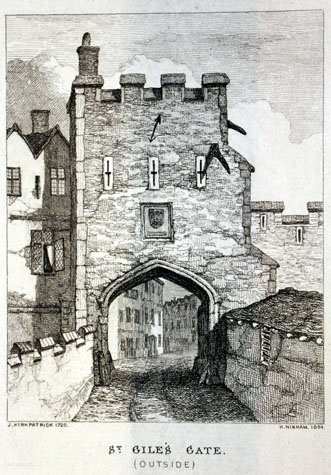
[1] The gate from the west, from outside the city. The
illustration by H Ninham was produced in 1864 but was based on an early
18th-century sketch by John Kirkpatrick. [Norwich
Castle Museum and Art Gallery 1954. 138, Todd 5, Norwich, 110a]
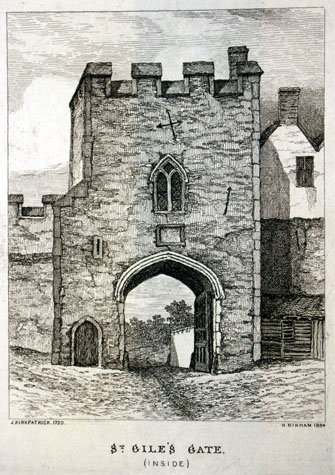
[2] View of the inside of St Giles Gate about 1720 engraved by
Henry Ninham from the drawing by John Kirkpatrick [Norwich
Castle Museum and Art Gallery 1954.138, Todd 5, Norwich, 110b]
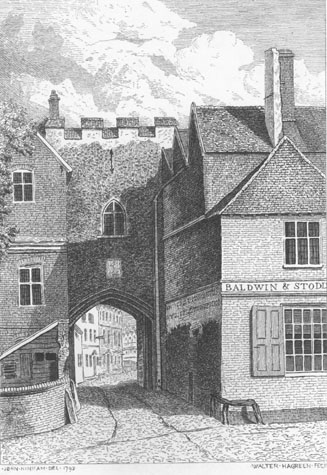
[3] View of the outside of the gateway in 1791 by John Ninham published by Fitch in 1861.
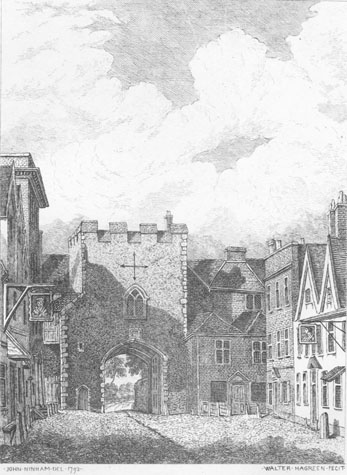
[4] View of the inside of the gateway in 1791 by John Ninham published by Fitch.
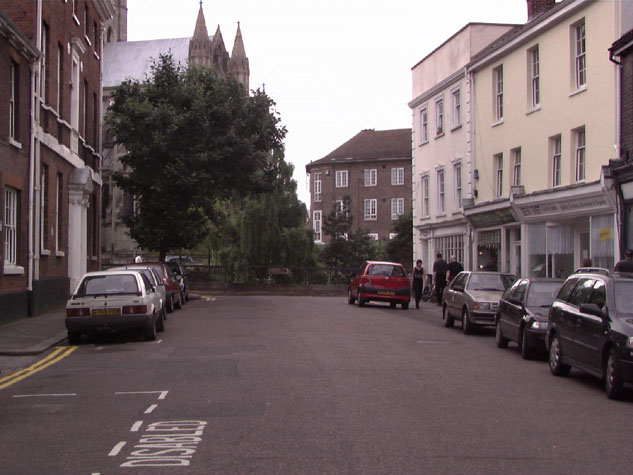
[5] View of the site of the gate from the east looking along Upper St Giles Street.
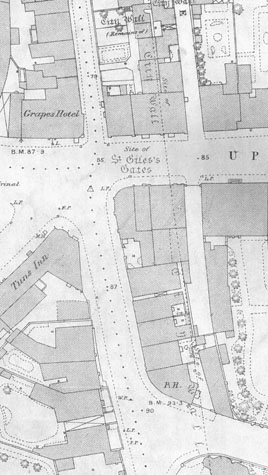
[6] Detail of the first edition of the Ordnance Survey map surveyed
in 1883 and published in 1885. Sheet LXIII.II.17
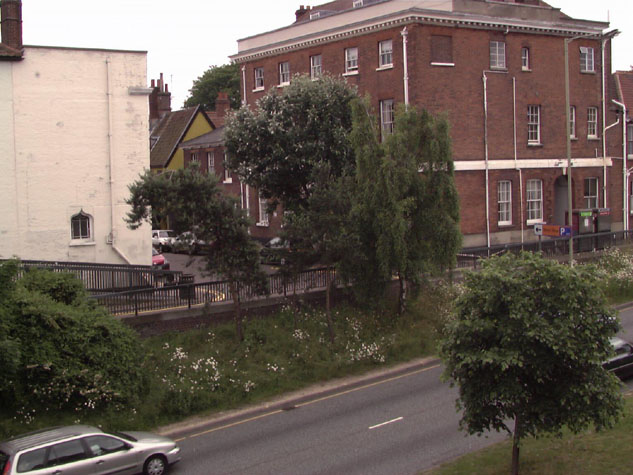
[7] View of the site of the gate from the north west.
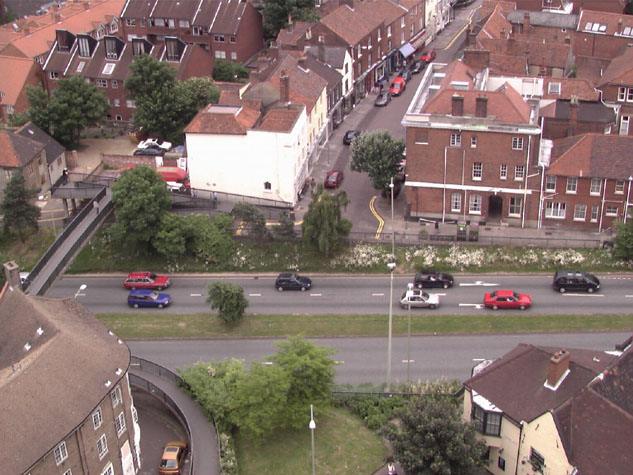
[8] View from the west looking down Upper St Giles Street.
The carriageway in the foreground is on the line of the outer lane called
Grapes Hill in the 18th century, the further carriageway is on the line of
the ditch and the gate was in the area of the grass verge.
|
General description
John Kirkpatrick's depiction of the gate in 1720 was copied by
Henry Ninham in an engraving of 1864.[NCM Todd Collection, vol. II,
box 5, page 110a and 110b] He shows the gateway as relatively tall
with four merlons to the outside [1] and four towards the City. Flanking
the archway tightly on the outer side were the high parapet walls of
the bridge over the ditch. That to the north was curved and crenellated.
Above the archway was a single coat of arms said by Fitch to be the
arms of the city. [Fitch 1861, page 16] Below this, he says, there
was an inscription carved in stone that read:
ADORNATA TEMPORE
MAIORALTIS HENRICI
CROWE ARMIGERI
1679
Above the arms are shown three cross-shaped loops which appear to
be cut in stone. On the north side of the gateway is shown a chimney
presumably serving a fireplace in the upper chamber and on the south-west
corner is what appears to be a broad buttress with two off sets.
The view of the inside of the gate shows a two-light window with
Y-shaped tracery to the chamber over the arch and a plaque or inscription
below the sill and above the arch. [2] The window, on stylistic
grounds, probably dated from the middle of the 14th century. On the
south-east corner is shown a low stair turret with its own low and
arched doorway to the lane. The stair rises just to the chamber over
the arch and the vice is lit by a loop at an intermediate level.
Presumably there was either an internal stair or a ladder to give
access to the roof over the chamber.
The wall to the south is shown as surviving to its full height with
crenellations but the wall to the north had been, in part, over built
by a timber-framed house with prominent gabled dormers.
John Ninham's drawings of the gate in 1792 (published by Fitch in
1861) show that the out side of the gate had been built against on
both sides and the loops had been replaced with a cross-mullioned
window with an arched head. [3 & 4] Also, on the inside, houses
pressed hard against the gateway on both sides. [NCM Fitch Collection
1766.76.94] The three-storey house with a straight parapet shown by
Ninham on the north side of St Giles survives. [5] This makes it
possible to judge more accurately the scale and bulk of the lost gate.
Documentary evidence:
In 1290 flood waters ran right up to the foot of St. Giles Gate.
[Blomefield, page 66]
Blomefield notes that in 1377 on St. Giles gate and wicket there
were 15 battlements, while the wall from St. Stephen's gate to St.
Giles gate had upon it 229 battlements, and from St. Giles to St. Benet's
gates there were 100 battlements upon the wall. [Blomefield, page 98,
citing the Book of Customs] In 1451 and 1481 St. Giles Ward
was responsible for the repairs to the walls, towers, and St. Giles
Gates, to the tower on the north side of the gates, and that tower.
[Agistment for the Walls, Liber Albus f. 177; Hudson &
Tingey, vol. II, pages 313-15]
In 1549 several breaches were made in the walls between St Giles
and St. Stephen's during Kett's rebellion [Blomefield, page 248],
and in 1643 St Giles Gates were rampired during the Civil war, the
earth being later removed.[Blomefield, page 386]
The Tonnage Books for 1756 ordered that the wall (sic) next to
the gate was to be painted, the battlements repaired, and the top of
the roof protected from wet by the placement of a lead ring. In 1763
the city ordered that the gate be repaired 'by proper workmen',
and that the paving through and about the gate also be improved.
[N.R.O. NCR Case 19 Shelf C; Fitch, page 16]
Map evidence:
Although maps of the city from the 17th and early 18th century
show only a limited number of buildings near to the gate, by the time
that Hochstetter completed his map in 1789, there were houses against
the inside of the wall all down Grape Hill between St Giles' Gate and
St Benedict's Gate. This was just before the gate was demolished
and by that stage the ditch below the gate had been filled in and turned over to gardens.
Millard and Manning's map of 1830 shows the then recently-constructed
City Gaol outside the gate to the west and there were houses tightly
packed around St Giles Street on the site of the ditch. The density
of buildings over the site of the gate and ditch is shown clearly on
the first edition of the Ordnance Survey map surveyed in 1883. [6]
Present state: archaeology. conservation and potential excavations:
With the widening of Grape Hill in the 1970s all these buildings
were demolished. The level of the road was lowered by a considerable
amount and archaeological evidence from the ditch and the bridge over
the ditch must have been destroyed. The site of the gate is at the
end of Upper St Giles Street, at the bottom of the ramp for the high
level footbridge over the inner ring road. [7 & 8]
In 1970 a stone was found built into or onto the city wall at
about 3-4ft distance from the road. It has been suggested that
this was a gate socket[SMR NF26171]
BIBLIOGRAPHY:
Atkin, Malcolm, 'The Chalk Tunnels of Norwich', Norfolk Archaeology, 38
part 3 (1983): 313-20, page 316
Blomefield, Francis, An Essay Towards the Topographical History of the
County of Norfolk, vol. III: The History and County of Norwich Part I
(London: W. Bulmer, 1806)
Buckler, J., 'St. Giles' Gate, Norwich', NCM 1941.12.6:INT
Collins, Arthur E., The Walls of Norwich (City and County of Norwich,
Norwich: Jarrold & Sons, 1910)
Fitch, Robert, Views of the Gates of Norwich made in the years 1792-3 by
the Late John Ninham (Norwich: Cundall, Miller, and Leavins, 1861)
Hudson, William, and Tingey, John C., The Records of the City of Norwich,
vol. II (Norwich & London: Jarrold & Sons, 1910)
Pococke, Edward, 'Sixteen Drawings of the Gates of Norwich', NCM
1955.219:IN
DOCUMENTARY REFERENCES:
N.R.O. Book of Customs
N.R.O. MF/RO 29/3 f. 177 (Liber Albus)
N.R.O. NCR Case 19 Shelf C (Tonnage Books, 1720-1836)
ARCHAEOLOGICAL REPORTS:
SMR NF261 1971
HISTORIC ILLUSTRATIONS IN THE DATABASE:
From Norwich Castle Museum and Art Gallery:
Ninham, Henry, from John Kirkpatrick, 'St. Giles Gates', NCM Todd
Collection, vol. II, box 5, page 110a
Ninham, John, 'St Giles Gate, Inside', NCM Fitch Collection 1766.76.94
Ninham, John, 'St. Giles Gate, Outside', NCM Fitch Collection 1765.76.94
|
